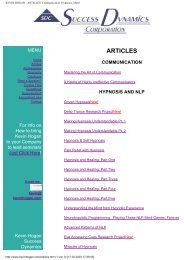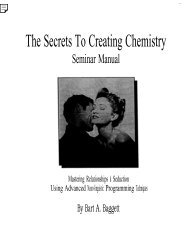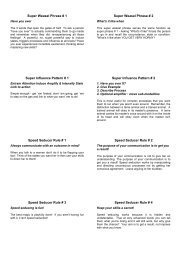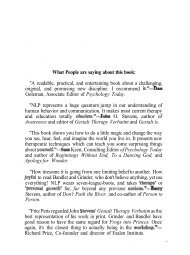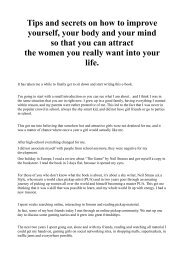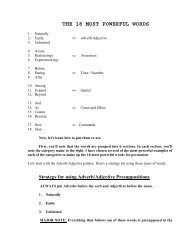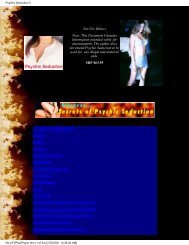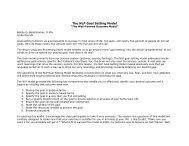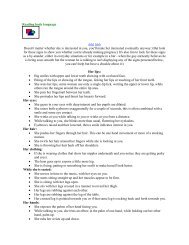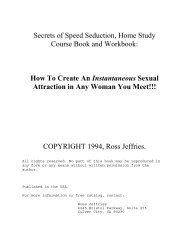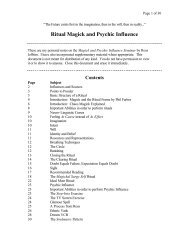A Pragmatic Guide To Communication & Change.pdf - NLP Info Centre
A Pragmatic Guide To Communication & Change.pdf - NLP Info Centre
A Pragmatic Guide To Communication & Change.pdf - NLP Info Centre
- No tags were found...
You also want an ePaper? Increase the reach of your titles
YUMPU automatically turns print PDFs into web optimized ePapers that Google loves.
the word "looking" refers to the movement of a person's eyes in the direction indicated.<br />
"Left" means towards that person's left, and "right" means towards his right. It is helpful<br />
to keep in mind that this accessing behavior represents "looking" internally. That is,<br />
during the moment of information retrieval, people arc generally not conscious of<br />
external visual stimuli. Rather, they are concentrating on internally stored or internally<br />
generated images, sounds, words, and feelings. Please notice also that the italicized words<br />
below indicate the kind of information being accessed.<br />
Looking up and to the right: Constructed images. 'these are visual images or<br />
pictures which are created by the individual. They can be recombinations of<br />
pieces of previously experienced visual input (see "eidetic images") into new or<br />
novel forms or sequences, or they can be created images which are constructed in<br />
response to other sensory stimuli. Constructed images are usually characterized by<br />
flatness or lack of depth and sometimes by a lack of color.<br />
Looking up and to the left: Eidetic images. These are stored visual images or<br />
pictures of past events and other previously experienced<br />
visual stimuli. This includes dreams and constructed images that have already been<br />
experienced. 'these images are usually characterized by having both depth and motion - as<br />
in u movie - as well as color.<br />
Looking level and to the right: Constructed speech. This pattern is usually associated with<br />
the process of creating spoken language. In this position, the person is "putting into<br />
words" what he wants to say next.<br />
Looking level and to the left: Remembered sound. This includes such tonal<br />
representation as the "alphabet tune" unit letters, advertisement jingles, phone numbers,<br />
and colloquialisms like slang and swearing. This is also where a person often moves the<br />
eyes when remembering auditory tape loops: messages stored in short, often tuneful or<br />
rhythmic patterns which have been so often repeated that the person has lost conscious<br />
awareness of their existence. One example of this is the "Remember- to - get - the - milk-on-theway-ho<br />
me<br />
from-work" line that is recited so often during the course of the morning that it eventually<br />
drops from conscious awareness.<br />
Note: The next two eye-scanning patterns are often reversed in both right and lefthanded<br />
people. It is important to determine which pattern is being used by an individual<br />
(see "Mapping") before you can use the information gained from observing these eye<br />
movements.<br />
Looking down and to the right: Feelings. In this position a person can access both<br />
derived feelings (emotions) and stored kinesthetic memories. Think of the position you<br />
often see a depressed person in: head bowed, shoulders<br />
As if the ceiling behind me could somehow give him the answer, he searched intently<br />
back ;rnd forth over my brow, saying, "Let me see now."<br />
This person's words provide one immediate clue: he is somehow visually "Searching" for<br />
information. And again we are presented with analog gesturing just as infonnativc as the<br />
words: what he is doing with his eyes.<br />
In the mid-1070's Bundle, and Grinder hegan to study the patterns of movements of<br />
people's eyes it, people thought and spoke.'fhey discovered that these movements<br />
correlated fairly well with fertain types of information rctrievel behaviors. 'Chest<br />
systematic patterns of behavior were eventually formalized into ;3 model called accessing



